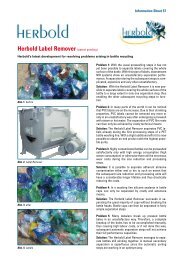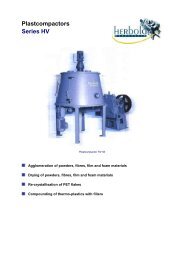Herbold Washing Lines Modular Washing Lines for Post-Consumer ...
Herbold Washing Lines Modular Washing Lines for Post-Consumer ...
Herbold Washing Lines Modular Washing Lines for Post-Consumer ...
You also want an ePaper? Increase the reach of your titles
YUMPU automatically turns print PDFs into web optimized ePapers that Google loves.
<strong>Herbold</strong> <strong>Washing</strong> <strong>Lines</strong><br />
<strong>Modular</strong> <strong>Washing</strong><br />
<strong>Lines</strong> <strong>for</strong><br />
<strong>Post</strong>-<strong>Consumer</strong><br />
Polyester (PET) Bottles<br />
A modular system: according to the required degree of<br />
cleanliness<br />
<strong>for</strong> the final product there is a choice of different<br />
components that can be supplied<br />
Simple structures <strong>for</strong> simple applications<br />
Complex structures <strong>for</strong> complex applications<br />
Hot Wash Step
Procedure steps<br />
in PET-bottle recycling<br />
Preparation of PET bottles Size Reduction<br />
A1 Debaling<br />
A screw shredder or a debaling drum breaks down<br />
the pressed bales into single bottles.<br />
A2 Breaking down of briquettes<br />
A shredder breaks down highly compressed parts<br />
into single bottles.<br />
A3 (Automatic) sorting of bottles<br />
Identifies and separates <strong>for</strong>eign plastic bodies with<br />
the help of electro-optical sensors.<br />
A4 (Manual) sorting of bottles<br />
Operators sort out <strong>for</strong>eign plastic bodies, possibly<br />
with the help of ultraviolet ligth.<br />
A5 Prewashing of bottles<br />
With the help of warm and cold water coarse<br />
contamination is partly removed in a washing drum<br />
or screw (alternative to A6+7).<br />
A6 Precrushing (dry)<br />
A shredder or granulator reduces the bottles<br />
without water into cuttings of 30 - 60 mm.<br />
A7 Air separation<br />
Bottle cuttings are separated from film and paper<br />
labels in the air stream.<br />
A8 Metal separation<br />
With a magnet or a detector most <strong>for</strong>eign metal<br />
bodies are separated.<br />
B1 Wet grinding<br />
A wet granulator size-reduces the bottles while<br />
the wash water removes paper and <strong>for</strong>eign body<br />
contamination from the flakes.<br />
B2 Separation of dirty water<br />
The wash water from the granulator is separated<br />
from the PET flakes.<br />
Separation in water<br />
C1 Density separation step<br />
In the water bath or with a hydrocyclone a light<br />
fraction (mostly polyolefines) is separated from<br />
the heavy fraction (mostly polyesters).<br />
C2 Water separation sediments<br />
The polyester fraction is pre-dried.<br />
C3 Water separation floating material<br />
The polyolefine is pre-dried.<br />
C4 Air separation floating material<br />
Granular and film PE/PP are separated.
Hot washing step Treatment of flakes<br />
D1 Material storage basin / preheating<br />
The flakes are heated to the temperature of the<br />
hot washing step.<br />
D2 Intensiv washing and dispersion<br />
The flakes are thoroughly washed in hot water,<br />
caustic soda and detergents; glues are dissolved.<br />
D3 Separation of heavy materials<br />
Materials heavier than polyester (glass, stones,<br />
metals) are separated in the bulk material<br />
cyclone.<br />
D4 Separation according to density<br />
In a hydrocyclone remaining polyolefines and<br />
floating glues are separated from the polyester.<br />
D5 Separation of the suds<br />
The hot wash water with the detergents in it is<br />
separated from the flakes.<br />
D6Treatmentofthesuds<br />
The hot wash water is enriched with lye and<br />
detergents.<br />
D7 Clean rinsing<br />
The clean flakes are rinsed in water in order to<br />
obtain a neutral pH value.<br />
D8 Mechanical drying<br />
The flakes are dried to the required residual<br />
moisture.<br />
E1 Air separation<br />
Remaining film and polyester dust are<br />
separated from the flakes.<br />
E2 Metal separation<br />
Remaining metals are separated.<br />
E3 Color and material separation<br />
An electro-optical particle separation unit<br />
separates remaining <strong>for</strong>eign plastic bodies<br />
(mostly PVC) and undesired color flakes.<br />
E4 Increase of the bulk density<br />
A secondary granulator improves the bulk<br />
density and the flowability of the flakes.<br />
E5 Bulk density and crystallization<br />
A plastcompactor improves the flowability, bulk<br />
density and recrystallizes the flakes.<br />
Water Treatment<br />
F1 Water collection, screening<br />
The dirty water is collected in a pit and any<br />
contamination larger than appr. 0.1 mm is<br />
removed.<br />
F2 Sedimentation<br />
The screened water is stored in a<br />
sedimentation basin <strong>for</strong> the sedimentation of<br />
light contamination; the result is circulation<br />
water.<br />
F3 Storage<br />
The mechanically treated circulation water is<br />
stored.<br />
F4 Treatment of fines<br />
In a chemical or physical water treatment plant.<br />
F5 Reconveying into the plant<br />
A pump conveys the circulation water back into<br />
the plant.<br />
F6 Neutralisation (waste water)<br />
Decrease of the pH value according to the<br />
regultions <strong>for</strong> public water treatment.
These functional units represent possible procedure steps<br />
when PET bottles are recycled.<br />
They are selected according to the frame paramenters of<br />
the feed material and the desired final product when such<br />
a plant is designed.<br />
The single functional units are combined with conveying<br />
systems (belt conveyors, conveying screws, elevators,<br />
blowers, pumps) appropriate to the specific nature of the<br />
product and in relation to their location. Type and volume<br />
of the necessary conveying systems are determined in<br />
respect to the project.<br />
Swim-Sink-Tank<br />
<strong>Washing</strong> Mill with Friction Washer<br />
Hot Air Dryer<br />
HERBOLD also manufactures and supplies<br />
washing lines <strong>for</strong> agricultural film, bottles, waste<br />
bins, post-consumer plastic waste and waste from<br />
car batteries and casings. Please ask <strong>for</strong> our<br />
general brochure on washing lines.<br />
Our product range<br />
Granulators<br />
Pulverizing systems<br />
Shredders<br />
Hammer mills<br />
Guillotines<br />
Complete washing systems and components<br />
HOG Shredders<br />
Plastcompactors
Specifications are not binding and subject to<br />
change without notice - 04/2004<br />
<strong>Herbold</strong> Meckesheim GmbH<br />
Industriestrasse 33<br />
D-74909 Meckesheim<br />
<strong>Post</strong>fach 218<br />
D-74908 Meckesheim<br />
Tel.: +49 (0) 62 26 / 932-0<br />
Fax: +49 (0) 62 26 / 6 04 55<br />
E-Mail: <strong>Herbold</strong>@<strong>Herbold</strong>.com<br />
Internet: http://www.herbold.com<br />
<strong>Herbold</strong> Our US-subsidiary: Meckesheim USA<br />
Resource Recycling Systems, Inc.<br />
Resource Recycling Systems<br />
333 Inc. George <strong>Washing</strong>ton Highway<br />
Smithfield, 333 George Rhode <strong>Washing</strong>ton Island 02917<br />
Highway,<br />
Phone: Smithfield 401-232-3354<br />
Rhode Island 02917<br />
Toll-Free: 888-612-7774<br />
Fax: Phone: 401-3223-5425<br />
+1 401 232 3354<br />
Fax: +1 401 232 5425<br />
E-Mail: info@herboldusa.net<br />
E-Mail:<br />
Internet: info@resourcerecycling.net<br />
www.herboldusa.net<br />
Internet:<br />
www.resourcerecycling.net




